吃透Java IO:字节流、字符流、缓冲流
前言
有人曾问fastjson的作者(阿里技术专家高铁):“你开发fastjson,没得到什么好处,反而挨了骂背了锅,这种事情你为什么要做呢?” 高铁答道:“因为热爱本身,就是奖励啊!” 这个回答顿时触动了我。想想自己,又何尝不是如此。
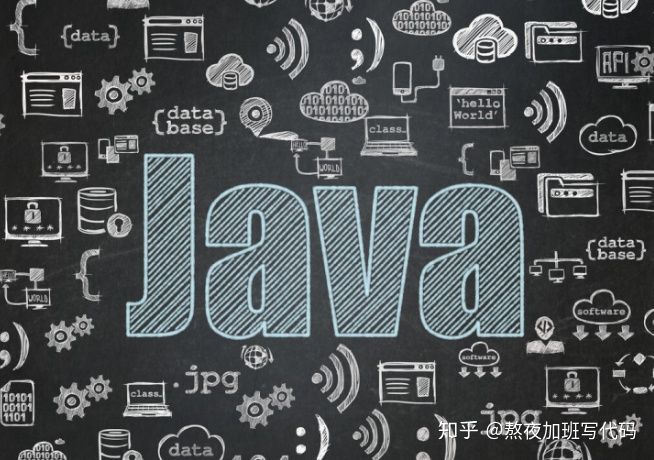
IO流是Java中的一个重要构成部分,也是我们经常打交道的。
下面几个问题(问题还会继续补充),如果你能对答如流,那么恭喜你,IO知识掌握得很好,可以立即关闭文章。反之,你可以在后面得文章中寻找答案。
- Java IO流有什么特点?
- Java IO流分为几种类型?
- 字节流和字符流的关系与区别?
- 字符流是否使用了缓冲?
- 缓冲流的效率一定高吗?为什么?
- 缓冲流体现了Java中的哪种设计模式思想?
- 为什么要实现序列化?如何实现序列化?
- 序列化数据后,再次修改类文件,读取数据会出问题,如何解决呢?
1 初识Java IO
IO,即in和out,也就是输入和输出,指应用程序和外部设备之间的数据传递,常见的外部设备包括文件、管道、网络连接。
Java 中是通过流处理IO 的,那么什么是流?
流(Stream),是一个抽象的概念,是指一连串的数据(字符或字节),是以先进先出的方式发送信息的通道。
当程序需要读取数据的时候,就会开启一个通向数据源的流,这个数据源可以是文件,内存,或是网络连接。类似的,当程序需要写入数据的时候,就会开启一个通向目的地的流。这时候你就可以想象数据好像在这其中“流”动一样。
一般来说关于流的特性有下面几点:
- 先进先出:最先写入输出流的数据最先被输入流读取到。
- 顺序存取:可以一个接一个地往流中写入一串字节,读出时也将按写入顺序读取一串字节,不能随机访问中间的数据。(
RandomAccessFile除外) - 只读或只写:每个流只能是输入流或输出流的一种,不能同时具备两个功能,输入流只能进行读操作,对输出流只能进行写操作。在一个数据传输通道中,如果既要写入数据,又要读取数据,则要分别提供两个流。
1.1 IO流分类
IO流主要的分类方式有以下3种:
- 按数据流的方向:输入流、输出流
- 按处理数据单位:字节流、字符流
- 按功能:节点流、处理流
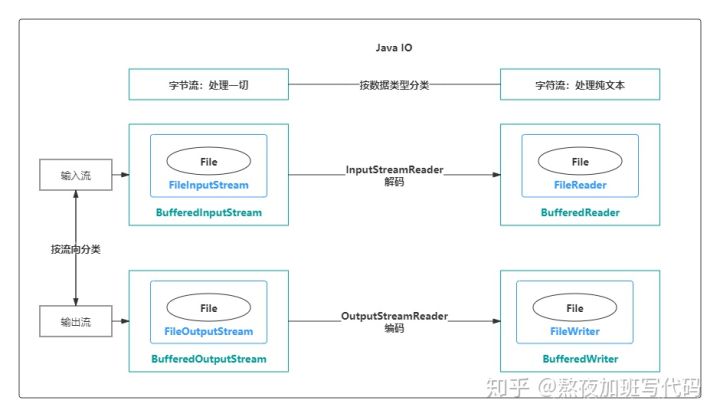
1、输入流与输出流
输入与输出是相对于应用程序而言的,比如文件读写,读取文件是输入流,写文件是输出流,这点很容易搞反。

2、字节流与字符流
字节流和字符流的用法几乎完成全一样,区别在于字节流和字符流所操作的数据单元不同,字节流操作的单元是数据单元是8位的字节,字符流操作的是数据单元为16位的字符。
为什么要有字符流?
Java中字符是采用Unicode标准,Unicode 编码中,一个英文为一个字节,一个中文为两个字节。
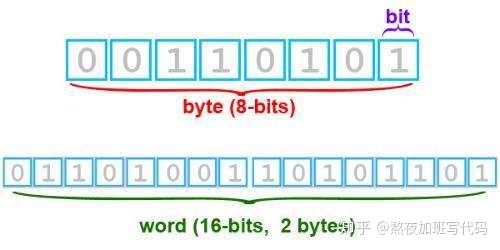
而在UTF-8编码中,一个中文字符是3个字节。例如下面图中,“云深不知处”5个中文对应的是15个字节:-28-70-111-26-73-79-28-72-115-25-97-91-27-92-124
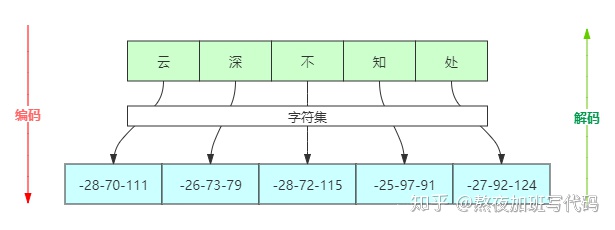
那么问题来了,如果使用字节流处理中文,如果一次读写一个字符对应的字节数就不会有问题,一旦将一个字符对应的字节分裂开来,就会出现乱码了。为了更方便地处理中文这些字符,Java就推出了字符流。
字节流和字符流的其他区别:
- 字节流一般用来处理图像、视频、音频、PPT、Word等类型的文件。字符流一般用于处理纯文本类型的文件,如TXT文件等,但不能处理图像视频等非文本文件。用一句话说就是:字节流可以处理一切文件,而字符流只能处理纯文本文件。
- 字节流本身没有缓冲区,缓冲字节流相对于字节流,效率提升非常高。而字符流本身就带有缓冲区,缓冲字符流相对于字符流效率提升就不是那么大了。详见文末效率对比。
以写文件为例,我们查看字符流的源码,发现确实有利用到缓冲区:
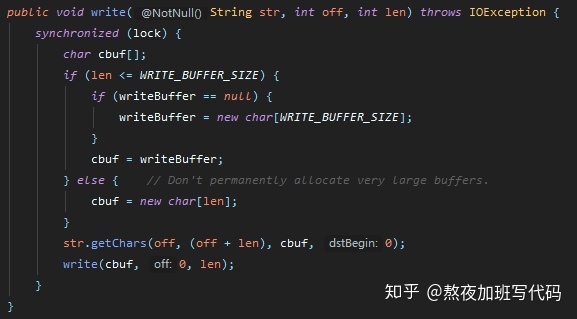
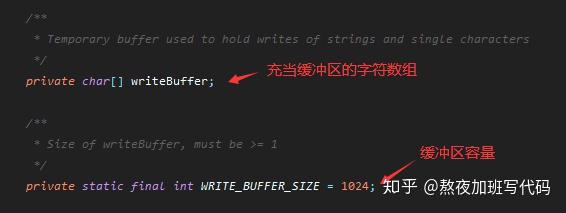
3、节点流和处理流
节点流:直接操作数据读写的流类,比如FileInputStream
处理流:对一个已存在的流的链接和封装,通过对数据进行处理为程序提供功能强大、灵活的读写功能,例如BufferedInputStream(缓冲字节流)
处理流和节点流应用了Java的装饰者设计模式。
下图就很形象地描绘了节点流和处理流,处理流是对节点流的封装,最终的数据处理还是由节点流完成的。
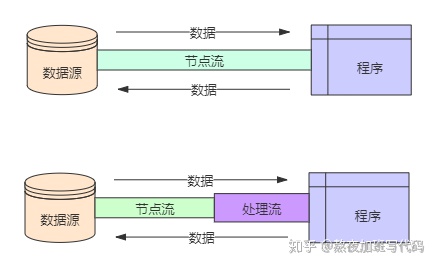
在诸多处理流中,有一个非常重要,那就是缓冲流。
我们知道,程序与磁盘的交互相对于内存运算是很慢的,容易成为程序的性能瓶颈。减少程序与磁盘的交互,是提升程序效率一种有效手段。缓冲流,就应用这种思路:普通流每次读写一个字节,而缓冲流在内存中设置一个缓存区,缓冲区先存储足够的待操作数据后,再与内存或磁盘进行交互。这样,在总数据量不变的情况下,通过提高每次交互的数据量,减少了交互次数。
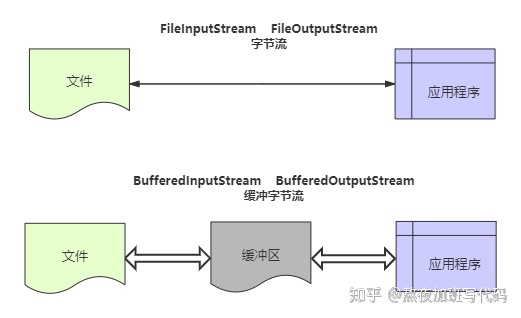
联想一下生活中的例子,我们搬砖的时候,一块一块地往车上装肯定是很低效的。我们可以使用一个小推车,先把砖装到小推车上,再把这小推车推到车前,把砖装到车上。这个例子中,小推车可以视为缓冲区,小推车的存在,减少了我们装车次数,从而提高了效率。

需要注意的是,缓冲流效率一定高吗?不一定,某些情形下,缓冲流效率反而更低,具体请见IO流效率对比。
完整的IO分类图如下:
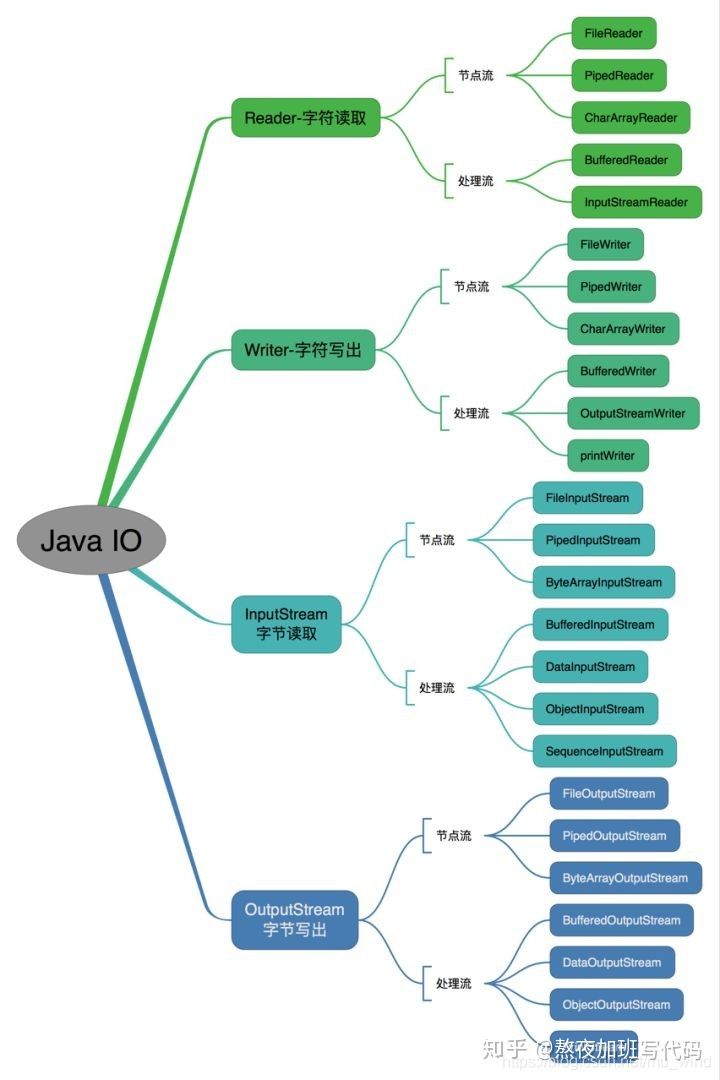
1.2 案例实操
接下来,我们看看如何使用Java IO。
文本读写的例子,也就是文章开头所说的,将“松下问童子,言师采药去。只在此山中,云深不知处。”写入本地文本,然后再从文件读取内容并输出到控制台。
1、FileInputStream、FileOutputStream(字节流)
字节流的方式效率较低,不建议使用
public class IOTest {
public static void main(String[] args) throws IOException {
File file = new File("D:/test.txt");
write(file);
System.out.println(read(file));
}
public static void write(File file) throws IOException {
OutputStream os = new FileOutputStream(file, true);
// 要写入的字符串
String string = "松下问童子,言师采药去。只在此山中,云深不知处。";
// 写入文件
os.write(string.getBytes());
// 关闭流
os.close();
}
public static String read(File file) throws IOException {
InputStream in = new FileInputStream(file);
// 一次性取多少个字节
byte[] bytes = new byte[1024];
// 用来接收读取的字节数组
StringBuilder sb = new StringBuilder();
// 读取到的字节数组长度,为-1时表示没有数据
int length = 0;
// 循环取数据
while ((length = in.read(bytes)) != -1) {
// 将读取的内容转换成字符串
sb.append(new String(bytes, 0, length));
}
// 关闭流
in.close();
return sb.toString();
}
}
2、BufferedInputStream、BufferedOutputStream(缓冲字节流)
缓冲字节流是为高效率而设计的,真正的读写操作还是靠
FileOutputStream和FileInputStream,所以其构造方法入参是这两个类的对象也就不奇怪了。
public class IOTest {
public static void write(File file) throws IOException {
// 缓冲字节流,提高了效率
BufferedOutputStream bis = new BufferedOutputStream(new FileOutputStream(file, true));
// 要写入的字符串
String string = "松下问童子,言师采药去。只在此山中,云深不知处。";
// 写入文件
bis.write(string.getBytes());
// 关闭流
bis.close();
}
public static String read(File file) throws IOException {
BufferedInputStream fis = new BufferedInputStream(new FileInputStream(file));
// 一次性取多少个字节
byte[] bytes = new byte[1024];
// 用来接收读取的字节数组
StringBuilder sb = new StringBuilder();
// 读取到的字节数组长度,为-1时表示没有数据
int length = 0;
// 循环取数据
while ((length = fis.read(bytes)) != -1) {
// 将读取的内容转换成字符串
sb.append(new String(bytes, 0, length));
}
// 关闭流
fis.close();
return sb.toString();
}
}
3、InputStreamReader、OutputStreamWriter(字符流)
字符流适用于文本文件的读写,
OutputStreamWriter类其实也是借助FileOutputStream类实现的,故其构造方法是FileOutputStream的对象
public class IOTest {
public static void write(File file) throws IOException {
// OutputStreamWriter可以显示指定字符集,否则使用默认字符集
OutputStreamWriter osw = new OutputStreamWriter(new FileOutputStream(file, true), "UTF-8");
// 要写入的字符串
String string = "松下问童子,言师采药去。只在此山中,云深不知处。";
osw.write(string);
osw.close();
}
public static String read(File file) throws IOException {
InputStreamReader isr = new InputStreamReader(new FileInputStream(file), "UTF-8");
// 字符数组:一次读取多少个字符
char[] chars = new char[1024];
// 每次读取的字符数组先append到StringBuilder中
StringBuilder sb = new StringBuilder();
// 读取到的字符数组长度,为-1时表示没有数据
int length;
// 循环取数据
while ((length = isr.read(chars)) != -1) {
// 将读取的内容转换成字符串
sb.append(chars, 0, length);
}
// 关闭流
isr.close();
return sb.toString()
}
}
4、字符流便捷类
Java提供了
FileWriter和FileReader简化字符流的读写,new FileWriter等同于new OutputStreamWriter(new FileOutputStream(file, true))
public class IOTest {
public static void write(File file) throws IOException {
FileWriter fw = new FileWriter(file, true);
// 要写入的字符串
String string = "松下问童子,言师采药去。只在此山中,云深不知处。";
fw.write(string);
fw.close();
}
public static String read(File file) throws IOException {
FileReader fr = new FileReader(file);
// 一次性取多少个字节
char[] chars = new char[1024];
// 用来接收读取的字节数组
StringBuilder sb = new StringBuilder();
// 读取到的字节数组长度,为-1时表示没有数据
int length;
// 循环取数据
while ((length = fr.read(chars)) != -1) {
// 将读取的内容转换成字符串
sb.append(chars, 0, length);
}
// 关闭流
fr.close();
return sb.toString();
}
}
5、BufferedReader、BufferedWriter(字符缓冲流)
public class IOTest {
public static void write(File file) throws IOException {
// BufferedWriter fw = new BufferedWriter(new OutputStreamWriter(new
// FileOutputStream(file, true), "UTF-8"));
// FileWriter可以大幅度简化代码
BufferedWriter bw = new BufferedWriter(new FileWriter(file, true));
// 要写入的字符串
String string = "松下问童子,言师采药去。只在此山中,云深不知处。";
bw.write(string);
bw.close();
}
public static String read(File file) throws IOException {
BufferedReader br = new BufferedReader(new FileReader(file));
// 用来接收读取的字节数组
StringBuilder sb = new StringBuilder();
// 按行读数据
String line;
// 循环取数据
while ((line = br.readLine()) != null) {
// 将读取的内容转换成字符串
sb.append(line);
}
// 关闭流
br.close();
return sb.toString();
}
}
2 IO流对象
第一节中,我们大致了解了IO,并完成了几个案例,但对IO还缺乏更详细的认知,那么接下来我们就对Java IO细细分解,梳理出完整的知识体系来。
Java种提供了40多个类,我们只需要详细了解一下其中比较重要的就可以满足日常应用了。
2.1 File类
File类是用来操作文件的类,但它不能操作文件中的数据。
public class File extends Object implements Serializable, Comparable<File>
File类实现了Serializable、 Comparable<File>,说明它是支持序列化和排序的。
File类的构造方法

File类的常用方法

File类使用实例
public class FileTest {
public static void main(String[] args) throws IOException {
File file = new File("C:/Mu/fileTest.txt");
// 判断文件是否存在
if (!file.exists()) {
// 不存在则创建
file.createNewFile();
}
System.out.println("文件的绝对路径:" + file.getAbsolutePath());
System.out.println("文件的大小:" + file.length());
// 刪除文件
file.delete();
}
}
2.2 字节流
InputStream与OutputStream是两个抽象类,是字节流的基类,所有具体的字节流实现类都是分别继承了这两个类。
以InputStream为例,它继承了Object,实现了Closeable
public abstract class InputStream
extends Object
implements Closeable
InputStream类有很多的实现子类,下面列举了一些比较常用的:
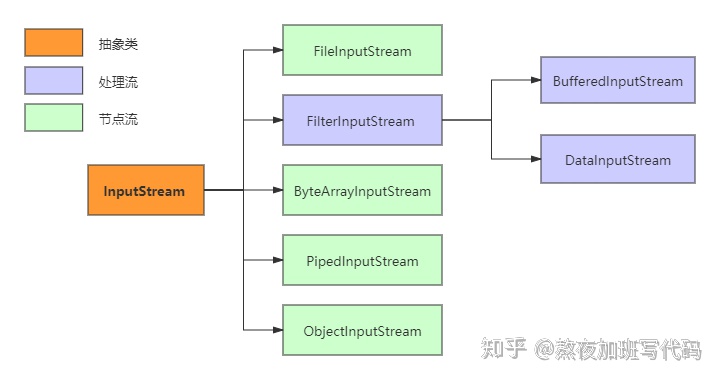
详细说明一下上图中的类:
InputStream:InputStream是所有字节输入流的抽象基类,前面说过抽象类不能被实例化,实际上是作为模板而存在的,为所有实现类定义了处理输入流的方法。FileInputSream:文件输入流,一个非常重要的字节输入流,用于对文件进行读取操作。PipedInputStream:管道字节输入流,能实现多线程间的管道通信。ByteArrayInputStream:字节数组输入流,从字节数组(byte[])中进行以字节为单位的读取,也就是将资源文件都以字节的形式存入到该类中的字节数组中去。FilterInputStream:装饰者类,具体的装饰者继承该类,这些类都是处理类,作用是对节点类进行封装,实现一些特殊功能。DataInputStream:数据输入流,它是用来装饰其它输入流,作用是“允许应用程序以与机器无关方式从底层输入流中读取基本 Java 数据类型”。BufferedInputStream:缓冲流,对节点流进行装饰,内部会有一个缓存区,用来存放字节,每次都是将缓存区存满然后发送,而不是一个字节或两个字节这样发送,效率更高。ObjectInputStream:对象输入流,用来提供对基本数据或对象的持久存储。通俗点说,也就是能直接传输对象,通常应用在反序列化中。它也是一种处理流,构造器的入参是一个InputStream的实例对象。
OutputStream类继承关系图:
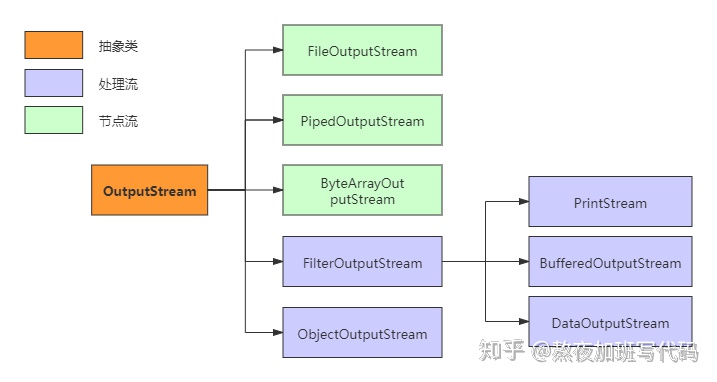
OutputStream类继承关系与InputStream类似,需要注意的是PrintStream.
2.3 字符流
与字节流类似,字符流也有两个抽象基类,分别是Reader和Writer。其他的字符流实现类都是继承了这两个类。
以Reader为例,它的主要实现子类如下图:
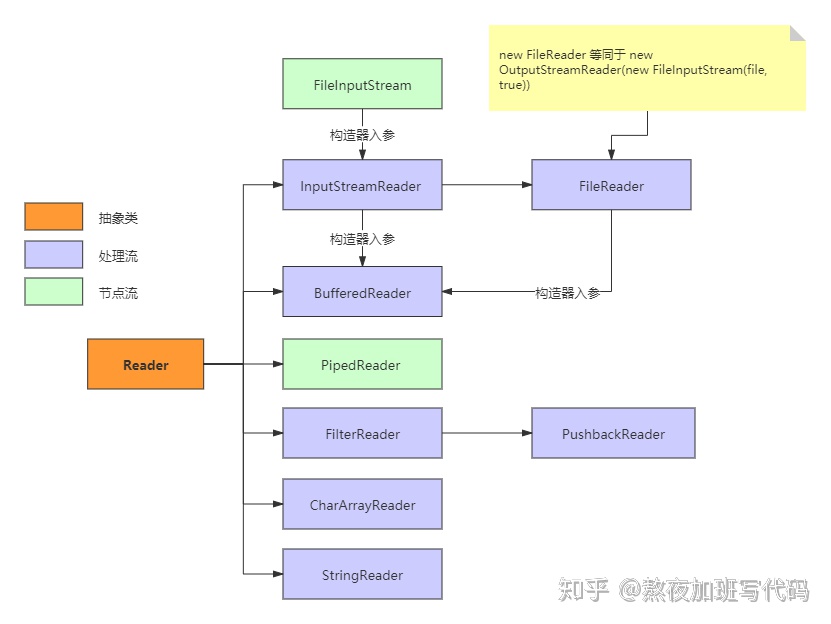
各个类的详细说明:
InputStreamReader:从字节流到字符流的桥梁(InputStreamReader构造器入参是FileInputStream的实例对象),它读取字节并使用指定的字符集将其解码为字符。它使用的字符集可以通过名称指定,也可以显式给定,或者可以接受平台的默认字符集。BufferedReader:从字符输入流中读取文本,设置一个缓冲区来提高效率。BufferedReader是对InputStreamReader的封装,前者构造器的入参就是后者的一个实例对象。FileReader:用于读取字符文件的便利类,new FileReader(File file)等同于new InputStreamReader(new FileInputStream(file, true),"UTF-8"),但FileReader不能指定字符编码和默认字节缓冲区大小。PipedReader:管道字符输入流。实现多线程间的管道通信。CharArrayReader:从Char数组中读取数据的介质流。StringReader:从String中读取数据的介质流。
Writer与Reader结构类似,方向相反,不再赘述。唯一有区别的是,Writer的子类PrintWriter。
2.4 序列化
待续…
3 IO流方法
3.1 字节流方法
字节输入流InputStream主要方法:
read():从此输入流中读取一个数据字节。read(byte[] b):从此输入流中将最多 b.length 个字节的数据读入一个 byte 数组中。read(byte[] b, int off, int len):从此输入流中将最多 len 个字节的数据读入一个 byte 数组中。close():关闭此输入流并释放与该流关联的所有系统资源。
字节输出流OutputStream主要方法:
write(byte[] b):将 b.length 个字节从指定 byte 数组写入此文件输出流中。write(byte[] b, int off, int len):将指定 byte 数组中从偏移量 off 开始的 len 个字节写入此文件输出流。write(int b):将指定字节写入此文件输出流。close():关闭此输入流并释放与该流关联的所有系统资源。
3.2 字符流方法
字符输入流Reader主要方法:
read():读取单个字符。read(char[] cbuf):将字符读入数组。read(char[] cbuf, int off, int len): 将字符读入数组的某一部分。read(CharBuffer target):试图将字符读入指定的字符缓冲区。flush():刷新该流的缓冲。close():关闭此流,但要先刷新它。
字符输出流Writer主要方法:
write(char[] cbuf):写入字符数组。write(char[] cbuf, int off, int len):写入字符数组的某一部分。write(int c):写入单个字符。write(String str):写入字符串。write(String str, int off, int len):写入字符串的某一部分。flush():刷新该流的缓冲。close():关闭此流,但要先刷新它。
另外,字符缓冲流还有两个独特的方法:
BufferedWriter类newLine():写入一个行分隔符。这个方法会自动适配所在系统的行分隔符。BufferedReader类readLine():读取一个文本行。
4 附加内容
4.1 位、字节、字符
字节(Byte)是计量单位,表示数据量多少,是计算机信息技术用于计量存储容量的一种计量单位,通常情况下一字节等于八位。
字符(Character)计算机中使用的字母、数字、字和符号,比如’A’、‘B’、’$’、’&'等。
一般在英文状态下一个字母或字符占用一个字节,一个汉字用两个字节表示。
字节与字符:
- ASCII 码中,一个英文字母(不分大小写)为一个字节,一个中文汉字为两个字节。
- UTF-8 编码中,一个英文字为一个字节,一个中文为三个字节。
- Unicode 编码中,一个英文为一个字节,一个中文为两个字节。
- 符号:英文标点为一个字节,中文标点为两个字节。例如:英文句号 . 占1个字节的大小,中文句号 。占2个字节的大小。
- UTF-16 编码中,一个英文字母字符或一个汉字字符存储都需要 2 个字节(Unicode 扩展区的一些汉字存储需要 4 个字节)。
- UTF-32 编码中,世界上任何字符的存储都需要 4 个字节。
4.2 IO流效率对比
首先,对比下普通字节流和缓冲字节流的效率:
public class MyTest {
public static void main(String[] args) throws IOException {
File file = new File("C:/Mu/test.txt");
StringBuilder sb = new StringBuilder();
for (int i = 0; i < 3000000; i++) {
sb.append("abcdefghigklmnopqrstuvwsyz");
}
byte[] bytes = sb.toString().getBytes();
long start = System.currentTimeMillis();
write(file, bytes);
long end = System.currentTimeMillis();
long start2 = System.currentTimeMillis();
bufferedWrite(file, bytes);
long end2 = System.currentTimeMillis();
System.out.println("普通字节流耗时:" + (end - start) + " ms");
System.out.println("缓冲字节流耗时:" + (end2 - start2) + " ms");
}
// 普通字节流
public static void write(File file, byte[] bytes) throws IOException {
OutputStream os = new FileOutputStream(file);
os.write(bytes);
os.close();
}
// 缓冲字节流
public static void bufferedWrite(File file, byte[] bytes) throws IOException {
BufferedOutputStream bo = new BufferedOutputStream(new FileOutputStream(file));
bo.write(bytes);
bo.close();
}
}
运行结果:
普通字节流耗时:250 ms
缓冲字节流耗时:268 ms
这个结果让我大跌眼镜,不是说好缓冲流效率很高么?要知道为什么,只能去源码里找答案了。翻看字节缓冲流的write方法:
public synchronized void write(byte b[], int off, int len) throws IOException {
if (len >= buf.length) {
/* If the request length exceeds the size of the output buffer,
flush the output buffer and then write the data directly.
In this way buffered streams will cascade harmlessly. */
flushBuffer();
out.write(b, off, len);
return;
}
if (len > buf.length - count) {
flushBuffer();
}
System.arraycopy(b, off, buf, count, len);
count += len;
}
注释里说得很明白:如果请求长度超过输出缓冲区的大小,刷新输出缓冲区,然后直接写入数据。这样,缓冲流将无害地级联。
但是,至于为什么这么设计,我没有想明白,有哪位明白的大佬可以留言指点一下。
基于上面的情形,要想对比普通字节流和缓冲字节流的效率差距,就要避免直接读写较长的字符串,于是,设计了下面这个对比案例:用字节流和缓冲字节流分别复制文件。
public class MyTest {
public static void main(String[] args) throws IOException {
File data = new File("C:/Mu/data.zip");
File a = new File("C:/Mu/a.zip");
File b = new File("C:/Mu/b.zip");
StringBuilder sb = new StringBuilder();
long start = System.currentTimeMillis();
copy(data, a);
long end = System.currentTimeMillis();
long start2 = System.currentTimeMillis();
bufferedCopy(data, b);
long end2 = System.currentTimeMillis();
System.out.println("普通字节流耗时:" + (end - start) + " ms");
System.out.println("缓冲字节流耗时:" + (end2 - start2) + " ms");
}
// 普通字节流
public static void copy(File in, File out) throws IOException {
// 封装数据源
InputStream is = new FileInputStream(in);
// 封装目的地
OutputStream os = new FileOutputStream(out);
int by = 0;
while ((by = is.read()) != -1) {
os.write(by);
}
is.close();
os.close();
}
// 缓冲字节流
public static void bufferedCopy(File in, File out) throws IOException {
// 封装数据源
BufferedInputStream bi = new BufferedInputStream(new FileInputStream(in));
// 封装目的地
BufferedOutputStream bo = new BufferedOutputStream(new FileOutputStream(out));
int by = 0;
while ((by = bi.read()) != -1) {
bo.write(by);
}
bo.close();
bi.close();
}
}
运行结果:
普通字节流耗时:184867 ms
缓冲字节流耗时:752 ms
这次,普通字节流和缓冲字节流的效率差异就很明显了,达到了245倍。
再看看字符流和缓冲字符流的效率对比:
public class IOTest {
public static void main(String[] args) throws IOException {
// 数据准备
dataReady();
File data = new File("C:/Mu/data.txt");
File a = new File("C:/Mu/a.txt");
File b = new File("C:/Mu/b.txt");
File c = new File("C:/Mu/c.txt");
long start = System.currentTimeMillis();
copy(data, a);
long end = System.currentTimeMillis();
long start2 = System.currentTimeMillis();
copyChars(data, b);
long end2 = System.currentTimeMillis();
long start3 = System.currentTimeMillis();
bufferedCopy(data, c);
long end3 = System.currentTimeMillis();
System.out.println("普通字节流1耗时:" + (end - start)
+ " ms,文件大小:" + a.length() / 1024 + " kb");
System.out.println("普通字节流2耗时:" + (end2 - start2)
+ " ms,文件大小:" + b.length() / 1024 + " kb");
System.out.println("缓冲字节流耗时:" + (end3 - start3)
+ " ms,文件大小:" + c.length() / 1024 + " kb");
}
// 普通字符流不使用数组
public static void copy(File in, File out) throws IOException {
Reader reader = new FileReader(in);
Writer writer = new FileWriter(out);
int ch = 0;
while ((ch = reader.read()) != -1) {
writer.write((char) ch);
}
reader.close();
writer.close();
}
// 普通字符流使用字符流
public static void copyChars(File in, File out) throws IOException {
Reader reader = new FileReader(in);
Writer writer = new FileWriter(out);
char[] chs = new char[1024];
while ((reader.read(chs)) != -1) {
writer.write(chs);
}
reader.close();
writer.close();
}
// 缓冲字符流
public static void bufferedCopy(File in, File out) throws IOException {
BufferedReader br = new BufferedReader(new FileReader(in));
BufferedWriter bw = new BufferedWriter(new FileWriter(out));
String line = null;
while ((line = br.readLine()) != null) {
bw.write(line);
bw.newLine();
bw.flush();
}
// 释放资源
bw.close();
br.close();
}
// 数据准备
public static void dataReady() throws IOException {
StringBuilder sb = new StringBuilder();
for (int i = 0; i < 600000; i++) {
sb.append("abcdefghijklmnopqrstuvwxyz");
}
OutputStream os = new FileOutputStream(new File("C:/Mu/data.txt"));
os.write(sb.toString().getBytes());
os.close();
System.out.println("完毕");
}
}
运行结果:
普通字符流1耗时:1337 ms,文件大小:15234 kb
普通字符流2耗时:82 ms,文件大小:15235 kb
缓冲字符流耗时:205 ms,文件大小:15234 kb
测试多次,结果差不多,可见字符缓冲流效率上并没有明显提高,我们更多的是要使用它的readLine()和newLine()方法。
本文由 创作,采用 知识共享署名4.0 国际许可协议进行许可。本站文章除注明转载/出处外,均为本站原创或翻译,转载前请务必署名。最后编辑时间为: 2020/11/28 03:24
